
It's Sunday and he's having Sunday dinner--after having Sunday breakfast and lunch and snacks in between, thank you.
He's on his way to becoming a Gulf Fritillary (Agraulis vanillae) butterfly.
Not!
A European paper wasp, Polistes dominula, circles, attacks, and the non-battle is over within seconds. The caterpillar is defenseless. The wasp is hungry. There is not much left.
Indeed, there isn't much left when European paper wasps descend on a Gulf Fritillary population. They eat the eggs, the caterpillars, the chrysalids, and the adults, carrying food back to their colony. Protein. Predators. Predators with a Purpose.
Do they attack adult butterflies? They do. We recently shared one of our images of a European paper wasp (EPW) attacking an adult Gulf Frit; it appears in the current edition of the University of Wyoming's Barnyards and Backyards. See PDF.
EPW is a relative newcomer to America. Native to the European and Asian continents, it was first discovered in the United States in the late 1970s and has spread throughout the country. It's often confused with the native yellowjacket. How can you easily distinguish them? The EPW's antennae are orange.
Entomologist Whitney Cranshaw of Colorado State University described the European paper wasp as a nuisance pest in a 2011 scientific article published in Southwestern Entomologist. In the abstract, he noted that it has "colonized much of Colorado during the past decade and has emerged as a dominant species of nuisance wasp. It is impacting many types of prey species, particularly larval Lepidoptera. However, in western Colorado it is also a common pest in fruit orchards and can be very damaging to ripening grapes, Vitis vinifera L.; sweet cherries, Prunus avium (L.) L.; and other thin-fleshed stone fruits. This latter habit is unusual for a Polistes species."
The EPW is considered by many as a beneficial insect, especially when it targets the caterpillars of cabbage white butterflies, alfalfa butterflies and other pests. Butterfly enthusiasts are none too happy, though, when it preys upon the preferred butterflies, including monarchs, Western tiger swallowtails and Gulf Fritillaries.
Meanwhile, back at the Passiflora. There's a population explosion of Gulf Frits. 'Cats all over the place. 'Cats eating leaves, flowers and stems. it's a veritable meat market for wasps (and spiders, praying mantids and other predators). The drama continues...
Attached Images:

A European paper wasp, Polistes dominula, attacks a Gulf Fritillary caterpillar. (Photo by Kathy Keatley Garvey)

The non-battle is over within seconds,as the wasp shreds the caterpillar. (Photo by Kathy Keatley Garvey)

Trapeze style, the predator devours its prey. (Photo by Kathy Keatley Garvey)

The European paper wasp finishes off the rest of the caterpillar. (Photo by Kathy Keatley Garvey)